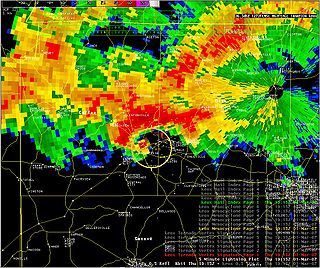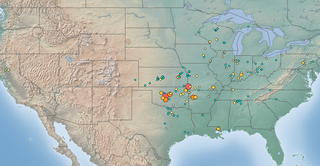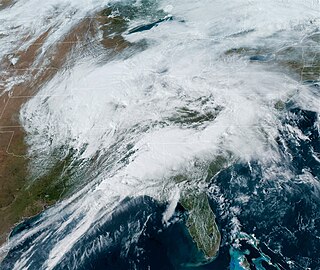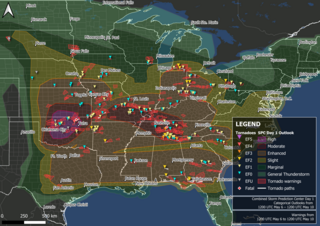
This page documents the tornadoes and tornado outbreaks that occurred in 2007,primarily in the United States. Most tornadoes form in the U.S.,although some events may take place internationally,particularly in parts of neighboring southern Canada during the summer season. Some tornadoes also take place in Europe,e. g. in the United Kingdom or in Germany.

The tornado outbreak of February 28 –March 2,2007 was a deadly tornado outbreak across the southern United States that began in Kansas on February 28,2007. The severe weather spread eastward on March 1 and left a deadly mark across the southern US,particularly in Alabama and Georgia. Twenty deaths were reported;one in Missouri,nine in Georgia,and 10 in Alabama. Scattered severe weather was also reported in North Carolina on March 2,producing the final tornado of the outbreak before the storms moved offshore into the Atlantic Ocean.
The tornado outbreak of March 28–31,2007,also known as the Late-March 2007 tornado outbreak,was a tornado outbreak that took place across the central United States. It developed in the High Plains from South Dakota to central Texas on March 28,2007,which produced most of the tornadoes. Several more tornadoes were reported the next three days before the system weakened on March 31. It affected western Nebraska,western Kansas,extreme eastern Colorado,and much of Oklahoma,and Texas. It was the second major outbreak of 2007,four weeks after an outbreak farther east. The outbreak produced 80 confirmed tornadoes,with five deaths and extensive damage being reported. In addition to the tornadoes,widespread hail as large as softballs and destructive straight-line winds as strong as 90 mph (140 km/h) were reported.

This page documents notable tornadoes and tornado outbreaks worldwide in 2008. Strong and destructive tornadoes form most frequently in the United States,Bangladesh,and Eastern India,but they can occur almost anywhere under the right conditions. Tornadoes also develop occasionally in southern Canada during the Northern Hemisphere's summer and somewhat regularly at other times of the year across Europe,Asia,and Australia. Tornadic events are often accompanied with other forms of severe weather,including strong thunderstorms,strong winds,and hail.

This page documents the tornadoes and tornado outbreaks of 2010. The majority of tornadoes form in the U.S.,but they can occur almost anywhere under the right conditions. A lesser number occur outside the U.S.,most notably in parts of neighboring southern Canada during the Northern Hemisphere's summer season,but are also known in South America,Europe,Asia,and Australia.

This page documents the tornadoes and tornado outbreaks of 2011. Extremely destructive tornadoes form most frequently in the United States,Bangladesh,Brazil and Eastern India,but they can occur almost anywhere under the right conditions. Tornadoes also appear regularly in neighboring southern Canada during the Northern Hemisphere's summer season,and somewhat regularly in Europe,Asia,and Australia.

The 2011 Super Outbreak was the largest,costliest,and one of the deadliest tornado outbreaks ever recorded,taking place in the Southern,Midwestern,and Northeastern United States from April 25 to 28,2011,leaving catastrophic destruction in its wake. Over 175 tornadoes struck Alabama,Mississippi,and Tennessee,which were the most severely damaged states. Other destructive tornadoes occurred in Arkansas,Georgia,Kentucky,Louisiana,New York,and Virginia,with storms also affecting other states in the Southern and Eastern United States. In total,367 tornadoes were confirmed by NOAA's National Weather Service (NWS) and Government of Canada's Environment Canada in 21 states from Texas to New York to southern Canada. Widespread and destructive tornadoes occurred on each day of the outbreak. April 27 was the most active day,with a record 223 tornadoes touching down that day from midnight to midnight CDT. Four of the tornadoes were rated EF5,which is the highest ranking on the Enhanced Fujita scale;typically these tornadoes are recorded no more than once a year.

From May 21 to May 26,2011,one of the largest tornado outbreaks on record affected the Midwestern and Southern regions of the United States. A six-day tornado outbreak sequence,most of the tornadoes developed in a corridor from Lake Superior southwest to central Texas,while isolated tornadoes occurred in other areas. An especially destructive EF5 tornado destroyed one-third of Joplin,Missouri,resulting in 158 deaths and over 1,000 injuries. The Joplin tornado was the deadliest in the United States since April 9,1947,when an intense tornado killed 181 in the Woodward,Oklahoma,area. Tornado-related deaths also occurred in Arkansas,Kansas,Minnesota,and Oklahoma. Overall,the tornado outbreak resulted in 186 deaths,8 of those non-tornadic,making it second only to the 2011 Super Outbreak as the deadliest since 1974. It was the second costliest tornado outbreak in United States history behind that same April 2011 outbreak,with insured damage estimated at $4–7 billion.

On March 2 and 3,2012,a deadly tornado outbreak occurred over a large section of the Southern United States into the Ohio Valley region. The storms resulted in 41 tornado-related fatalities,22 of which occurred in Kentucky. Tornado-related deaths also occurred in Alabama,Indiana,and Ohio. The outbreak was the second deadliest in early March for the U.S. since official records began in 1950;only the 1966 Candlestick Park tornado had a higher death toll for a tornadic system in early March.

This page documents the tornadoes and tornado outbreaks of 2014. Strong and destructive tornadoes form most frequently in the United States,Bangladesh,Brazil,and Eastern India,but they can occur almost anywhere under the right conditions. Tornadoes also appear regularly in neighboring southern Canada during the Northern Hemisphere's summer season,and somewhat regularly in Europe,Asia,and Australia.

The tornado outbreak of January 10–11,2020 was a two-day severe weather event stretching from the South-Central Plains eastward into the Southeast United States. An eastward-moving shortwave trough tracked across the continental United States through that two-day period,combining with abundant moisture,instability,and wind shear to promote the formation of a long-lived squall line. Hundreds of damaging wind reports were received,and 80 tornadoes occurred within this line,making it the third largest January tornado outbreak on record. Three tornadoes—an EF1 in eastern Texas,an EF2 in northern Louisiana,and an EF2 in western Alabama—led to a total of seven deaths,all in mobile homes. There were five other storm related deaths,including two due to icy roads in Lubbock,Texas,one due to drowning in Oklahoma,and one due to icy roads in Iowa. The system also brought a monthly record high temperature to Boston and Bridgeport. Extensive damage and several other injuries occurred as well. The severe weather event was notable in that it was forecast well in advance,with the Storm Prediction Center first highlighting the risk area a full week beforehand. Total damage from the event reached $1.1 billion according to the National Centers for Environmental Information.

On April 22,2020,an outbreak of discrete supercell thunderstorms across portions of Oklahoma,Texas,and Louisiana led to widespread severe weather,including multiple strong tornadoes. Two people were killed by a high-end EF2 that struck the town of Madill,Oklahoma,and three more were killed by an EF3 wedge tornado that moved through Onalaska,Texas. Dozens of others were injured as well. The event came to fruition as a trough progressed eastward across the United States,interacting with a moist and unstable environment. Tornado activity continued into Arkansas,Louisiana,Mississippi,Alabama,Florida,and Georgia overnight into the day on April 23. Isolated tornado activity also occurred during the overnight hours on April 21.

A significant tornado outbreak sequence took place from March 24–28,2021 in the Southern United States,just one week after another outbreak affected similar regions. There were 43 tornadoes confirmed across 11 states,with the bulk of activity primarily on March 25,which resulted in the Storm Prediction Center (SPC) issuing its second high-risk outlook for the month of March,as well as the second high-risk outlook for 2021. Several intense tornadoes touched down on that day,including ones that prompted the issuance of rare tornado emergencies near Hoover,Alabama,Brent and Centreville,Alabama,and in the Newnan,Georgia area. March 27 also saw widespread tornado activity mainly across East Texas,Southern Arkansas,Louisiana,and Western Tennessee with several strong tornadoes touching down. Scattered to widespread wind and hail damage occurred throughout the outbreak sequence,and repeated rounds of heavy rain caused widespread severe flash and river flooding across much of Tennessee.

A significant early spring tornado outbreak occurred during the afternoon and evening hours of March 5,2022 in the Midwest,primarily in the state of Iowa,before transitioning to a damaging wind event across northern parts of Illinois and Indiana. Multiple tornadoes were reported,several of which were produced by a dominant supercell thunderstorm in central Iowa. One long-track,low-end EF4 tornado caused major damage near the towns of Winterset and Norwalk,resulting in six fatalities. Multiple other supercells spawned along an area of moderate destabilization in northern Missouri,prompting further tornado warnings in southern Iowa,as they entered a highly favorable environment for maturing. Large hail and damaging wind gusts accompanied the storms,which continued their passage across the Midwestern states into overnight. More tornadic weather was confirmed in Arkansas and Missouri the next day and into the early morning of March 7. In addition to that,straight line winds killed one person near Hazel,Kentucky when a semi trailer was blown over on US 641. Another non-tornadic fatality occurred in western New York as the storm approached.

From April 4–5,2022,a mesoscale convective system and numerous discrete supercells produced a swath of severe weather and several tornadoes in the Southeastern United States,including several strong,long tracked tornadoes. An EF3 tornado damaged or destroyed several homes in Bonaire,Georgia while a large EF3 tornado prompted a tornado emergency for Allendale and Sycamore,South Carolina. A violent EF4 tornado in Black Creek,Georgia resulted in one fatality as it destroyed several neighborhoods,and another large EF3 tornado caused widespread heavy tree damage northeast of Ulmer,South Carolina. More severe storms occurred across a large portion of the Southeast ahead of a cold front on April 6–7,with more tornadoes reported in South and Central Georgia and further south into Florida,all of which were weak. Along with the one tornadic death,trees felled by straight-line winds killed one person each in Louisiana and Texas.

A four-day tornado outbreak affected the Central and Southern United States in mid-December 2022. The outbreak produced strong tornadoes in Oklahoma,Texas,Louisiana,Mississippi,Alabama,and Georgia,resulting in severe damage and three fatalities. On December 13,a high-end EF1 tornado was caught on video from multiple angles as it caused considerable damage in Grapevine,Texas,where five people were injured,and multiple EF2 tornadoes caused significant damage in other parts of Texas and Oklahoma that morning. Two large EF2 tornadoes occurred near DeBerry,Texas and Keachi,Louisiana to the southwest of Shreveport,Louisiana,with the second one causing severe damage and two fatalities. An EF3 tornado struck the northern fringes of Farmerville,causing major structural damage and 14 injuries.

A large,major,and deadly tornado outbreak occurred across the Central and Southern United States from May 6–10,2024,as a result of a slow-moving trough that was moving across the country. The Storm Prediction Center (SPC) issued a tornado-driven high risk convective outlook for portions of central Oklahoma and extreme southern Kansas early on May 6. Millions of people were put under a particularly dangerous situation (PDS) tornado watch later that evening,as many tornadoes were reported across the region,particularly in Oklahoma,where a violent EF4 tornado struck the towns of Barnsdall and Bartlesville,Oklahoma. Severe and tornadic weather spread eastward over the Mississippi,Ohio,and Tennessee Valleys over the next two days,with a nocturnal outbreak occurring in the latter on May 8,as tornadic supercell thunderstorms produced many tornadoes across the states of Tennessee,northern Alabama and western Georgia. The system responsible for the outbreak finally moved offshore by May 10 after producing several more tornadoes across the Southeast,including two EF2 tornadoes and hurricane-strength straight-line winds that moved through Tallahassee. This large outbreak came less than two weeks after a similarly large and deadly outbreak occurred across most of the same regions.

The 2011 Chickasha-Blanchard tornado was a large and extremely violent EF4 tornado that impacted the southern side of Chickasha,Oklahoma and rural areas around Blanchard and Newcastle,Oklahoma in the late afternoon of May 24,2011. The tornado killed one person and injured 48 others as the tornado traveled a path length of 33.3 miles with a peak path width of 880 yards. This powerful tornado was part of the Tornado outbreak sequence of May 21–26,2011 and was one of the strongest tornadoes in the sequence and was tied for the second strongest tornado of the May 24 outbreak,behind the El Reno–Piedmont tornado.





















